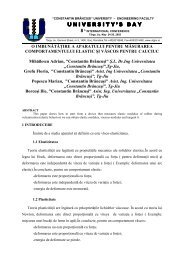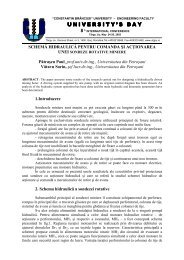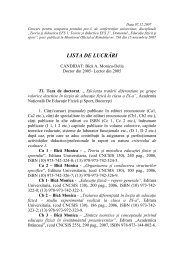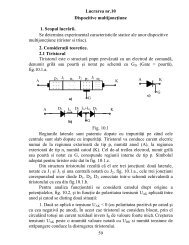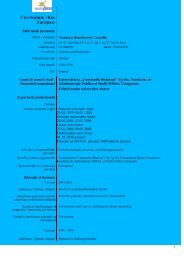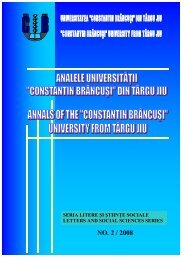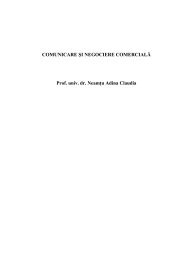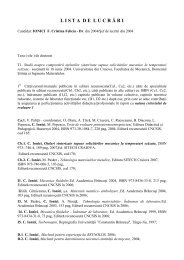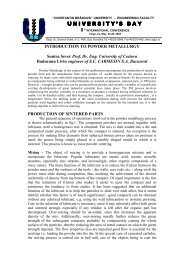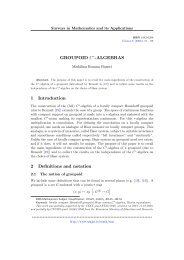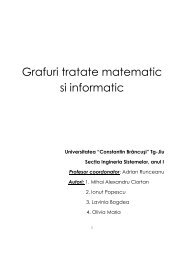UN PARADOX AL MODERNITĂŢII Lect. univ. dr. Curelar Mirabela ...
UN PARADOX AL MODERNITĂŢII Lect. univ. dr. Curelar Mirabela ...
UN PARADOX AL MODERNITĂŢII Lect. univ. dr. Curelar Mirabela ...
You also want an ePaper? Increase the reach of your titles
YUMPU automatically turns print PDFs into web optimized ePapers that Google loves.
Analele Universităţii “Constantin Brâncuşi” din Târgu Jiu, Seria Litere şi Ştiinţe Sociale, Nr. 1/2009<br />
perplexitate, groază, teroare. Coincidenţele<br />
stranii şi terifiante sunt uneori opera<br />
întâmplării sau rezultatul unei fatalităţi<br />
obscure.<br />
Caragiale a cercetat maniera<br />
fantastică a lui Edgar Allan Poe, capacitatea<br />
sa de a crea o atmosferă terifiantă, prin<br />
tehnica întreţinerii misterului, a tainei, a<br />
enigmei, motive întâlnite şi la Caragiale.<br />
Capodopera sa, Prăbuşirea casei Usher, ne<br />
introduce într-o atmosferă stranie, în care<br />
eroul este marcat de degenerescenţă şi<br />
anxietate, este bolnav de spaimă, stăpânit de<br />
groază, marcat de teroare, psihotic chiar,<br />
stare pusă de către autor în relaţie directă şi<br />
ocultă, cu vechimea şi şubrezenia clădirii,<br />
umezeala zidurilor, menţinând ambianţa de<br />
teroare a locurilor, cu elemente<br />
producătoare de coşmar.<br />
Dacă la Edgar Allan Poe descinderea<br />
în extraordinar şi straniu este o experienţă<br />
de tip gotic, urmărind să producă o surpriză<br />
înfricoşătoare, la Caragiale aventura îşi<br />
pierde stabilitatea, impunându-se o<br />
suprapunere între normal şi supranatural.<br />
Aceste accesorii parafantastice ţin să creeze<br />
ambianţa ororii în opera lui Caragiale.<br />
Finalul capodoperei caragialiene La hanul<br />
lui Mânjoală, prin arderea din temelii a<br />
hanului, pare un fel de prăbuşire a casei<br />
Usher. Ceea ce ne sugerează Caragiale este<br />
groaza, teroarea interioară şi psihică a<br />
personajelor. La Caragiale nu percepem<br />
simţământul groazei şi al remuşcării unui<br />
om care a ucis, ci groaza de a nu fi el ucis,<br />
frica de moarte.<br />
Taina din nuvela La hanul lui<br />
Mânjoală este dezlegată prin implicarea<br />
subiectului în realitate, starea de<br />
incertitudine, enigmele, notaţiile sufleteşti<br />
fiind relatate sub forma unor întâmplări<br />
posibile, obişnuite, chiar fireşti. Opera lui<br />
Caragiale are un substrat folcloric, în care<br />
fantasticul este plăsmuit în real, într-un<br />
decor deosebit de sugestiv, propriu<br />
întâmplărilor stranii şi practicilor magice ale<br />
hangiţei asupra călătorului sosit la han. În<br />
nuvela de faţă, „echivocul planurilor,<br />
anxiety, fright, perplexity, horror, terror.<br />
The strange and terrifying coincidences are<br />
sometimes the work of the occurrence or the<br />
result of an obscure fatum.<br />
Caragiale researched Edgar Allan<br />
Poe’s fantastical manner, his ability to<br />
create a terrifying atmosphere, by the<br />
technique of maintaining the mystery, the<br />
secret, the enigma, motifs that we also find<br />
at Caragiale. His masterpiece, Usher<br />
House’s Crush, introduces us into a strange<br />
atmosphere where the hero is marked by the<br />
degeneration and the anxiety, is sick of<br />
fright, governed by the horror, marked by<br />
the terror, even psychotic, a situation put by<br />
the author in a direct and obscure relation<br />
with the building’s antiquity and frailty, the<br />
wall’s humidity, maintaining the terror<br />
ambiance of the places, with elements that<br />
produce nightmares.<br />
If, at Edgar Allan Poe, the descent in<br />
the extraordinary and strange aspect is a<br />
gothic experience, following to produce a<br />
frightening surprise, at Caragiale, the<br />
adventure loses its stability, imposing a<br />
superposition between the normal and the<br />
supernatural aspect. These para-fantastical<br />
accessories want to create the horror<br />
ambiance in Caragiale’s work. The end of<br />
Mânjoală’ s Inn Caragialian masterpiece, by<br />
burning the inn, seems to be some kind of<br />
crush of the Usher house. Caragiale<br />
suggests us the horror, the characters’<br />
internal and mental terror. At Caragiale, we<br />
do not perceive the feeling of horror and<br />
compunction of a man who killed, but the<br />
horror of not being killed, the fright of<br />
death.<br />
The secret from the Mânjoală’s Inn<br />
short-story is solved by involving the<br />
subject in the reality, the insecurity, the<br />
enigmas, the soul notations being described<br />
as possible, usual, even natural situations.<br />
Caragiale’s work has a folkloric substratum<br />
where the fantasy is built in reality, in an<br />
extremely suggestive background,<br />
appropriate to the strange situations and<br />
magical practices of the landlady on the<br />
Annals of the „Constantin Brâncuşi” University of Târgu Jiu, Letters and Social Sciences Series, Issue 1/2009<br />
102




